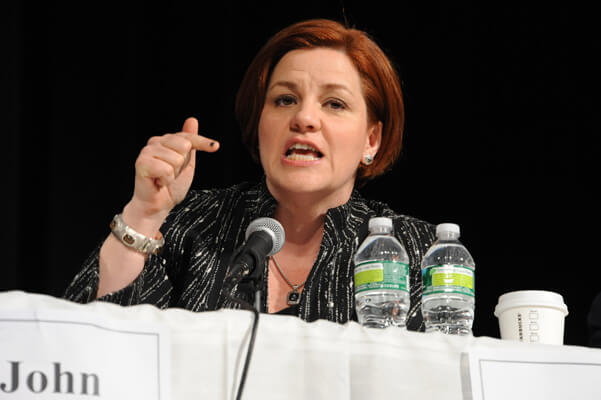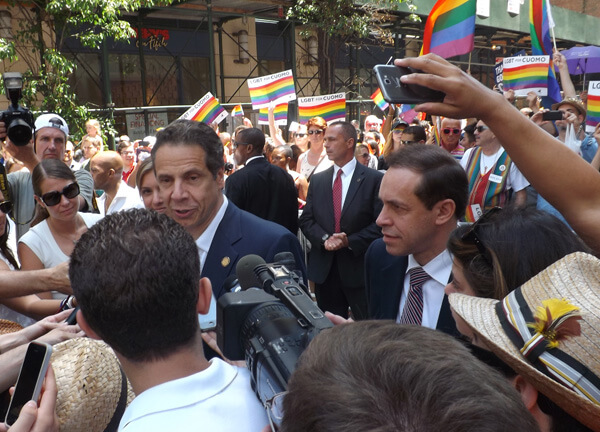Councilmember Corey Johnson, addressing the rally, said there's a “fighting chance” of securing the $10 million advocates are pressing for. | GAY CITY NEWS
AIDS groups gathered on the steps of City Hall to demand that the de Blasio administration contribute $10 million towards the Plan to End AIDS in the city budget for the fiscal year that begins on July 1.
“Ten million dollars is a nice first step,” said Corey Johnson, the gay city councilmember who chairs the Council’s Health Committee and is HIV-positive, at the June 18 rally. “Ten million is not going to get us the entire way so we’re calling on the city to step up.”
The rally, which drew about 70 people, was produced by the End AIDS NY 2020 Coalition, which is comprised of 60 AIDS groups. Many of the groups were on a task force, appointed by Governor Andrew Cuomo, that drafted the plan to reduce new HIV infections in New York from the current roughly 3,000 a year to 750 annually by 2020. The plan was endorsed by Cuomo and Mayor Bill de Blasio last year.
On City Hall steps, 70 gather to press mayor as budget negotiations near June 30 deadline
The task force members pressed the Cuomo administration to contribute at least $100 million to the plan in the current state fiscal year, which began on April 1. While Cuomo did negotiate reduced prices for the anti-HIV drugs that are a core component of the plan, the governor kicked in only $10 million. The coalition wants the city to match that amount in its budget.
“I don’t want to set expectations too high, but I feel like we have a fighting chance,” Johnson said at the rally.
The mayor’s preliminary budget, which was released on February 9, cut the budgets of the city health department and the Human Resources Administration, the two city agencies that will deliver most if not all of the resources for implementing the plan. In its response to the preliminary budget, the City Council proposed adding $9.7 million for the plan. While the cuts to the two agencies were partially restored in the mayor’s $78 billion executive budget, which was released on May 7, the City Council dollars were not included.
ACT UP New York member Jim Eigo addressing the June 18 rally. | GAY CITY NEWS
At the rally, Jim Eigo, a member of ACT UP New York, recalled a protest the AIDS activist group held on the steps of City Hall in 1987 when AIDS was burning through the city’s gay community. About 80 ACT UP members were escorted in by Miriam Friedlander, then a councilmember.
“We were now Miriam’s special guests and with her we proceeded to stage a fabulous, glorious protest,” Eigo said. “All that time later, AIDS is still with us… So why are we here? Eighty percent of the epidemic is here in the city. Until the city pays its share, we will not end the epidemic.”
In large measure, the plan will rely on pre-exposure prophylaxis (PrEP), post-exposure prophylaxis (PEP), and treatment as prevention (TasP) to prevent new HIV infections. PrEP involves the consistent use of anti-HIV drugs by uninfected people to prevent them from becoming infected. PEP is a 28-day course of anti-HIV drugs that prevents infection in someone with a recent exposure. TasP reduces the amount of virus in HIV-positive people so they cannot infect others. All three drug regimens are highly effective when taken correctly.
In an email, a City Hall spokesperson wrote, “Mayor de Blasio is deeply committed to ending the AIDS epidemic and has made key investments on the city-level, such as fully funding the HASA 30 percent rent cap. We are awaiting details on State funding for the blueprint and how it will be spent. Once we have those details, we will assess potential City funding.”
Last year, the state and city agreed to cap the rent paid by people with AIDS living in publicly-subsidized housing at 30 percent of their income. AIDS groups had long sought this protection for people with AIDS. The city is paying two-thirds of the cost and the state is covering the rest. To date, the benefit has cost the city at least $22 million.




































